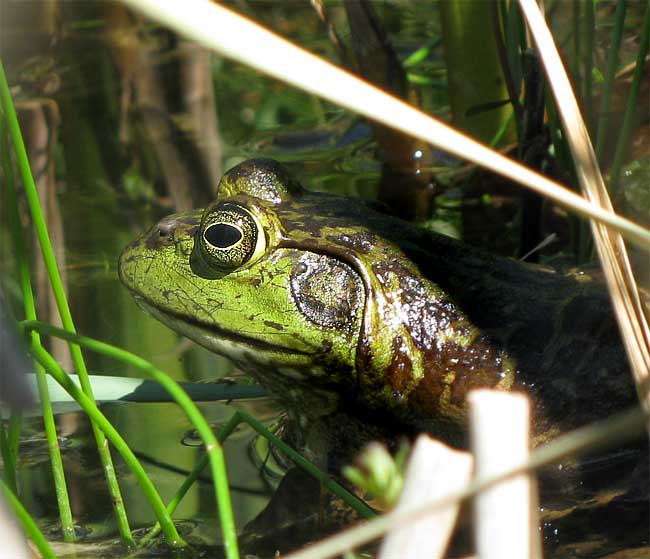Excerpts from Jim Conrad's
Naturalist Newsletter

from the May 24, 2009 Newsletter, issued from the Siskiyou Mountains west of Grants Pass, Oregon:
A TOUGH OLD BULLFROG
I still go sit among the cattails sometimes, just sit quietly for the pure pleasure of being there. The other day a big Bullfrog settled in next to me, since I was "invisible" by not moving. Slowly I got my camera in position and took a shot, which you see above.
He's an old, scarred-up one. I know he's a "he" because of the large, circular tympanum covering the ear area behind his eyes. Tympani of females are only slightly larger than the eyes, while this one's are much larger. I was looking right at this frog when a blue damselfly glided near, he lunged and gobbled it down and swallowed it, all in three to five seconds. Then back to his position for a long time, nothing moving but the thin, white skin beneath his mouth as he breathed.
By the way, the other day I walked up to the pond's bank and began peeing. A big bullfrog jumped out of the grass and tried to catch my stream of pee. How's
that for having your brain programmed to trigger an attack by movement?
from the Newsletter of June 19, 2005
issued from California's Sierra Nevada Foothills:
BULLFROGS HARRUMPING
On my way back from the hike I took a rest next to a little pond along the road. It wasn't long before from out of the dense cattails along shore the unmistakable bass voice of a big Bullfrog, LITHOBATES CATESBEIANUS, boomed across the water. This was answered by someone near me, and then someone else elsewhere. What a pleasure to sit cross-legged in tall grass next to an emerald-green pond hearing big Bullfrogs calling in the middle of a bright, summery day!
Then it occurred to me: I thought that Bullfrogs were Eastern...
It turns out that Bullfrogs were first introduced into California in 1895. Californians already had overharvested their native Red-legged Frogs, for eating, so Bullfrogs were meant to supplement the dwindling frog-leg supply. Today Bullfrogs are likely to occur in any California pond, lake or slow-moving stream below about 8000 feet.
As usually turns out when people introduce plants and animals where they shouldn't be, now Bullfrogs are endangering certain ecosystems. They diminish diversity by eating just about any animal that'll fit into their mouths -- including small snakes, turtles, birds, mammals and other frogs, even other Bullfrogs. In some areas where there's concern about disappearing frog and waterfowl species, Bullfrogs are eating both rare frogs and waterfowl chicks.
Bullfrogs are survivors, however. Their eggs are unpalatable to fish and their tadpoles stay inactive much of the time, making them less visible to predators.
And, if you've ever tried to sneak up on a bullfrog, you know that the adults are pretty sharp about protecting themselves, too.